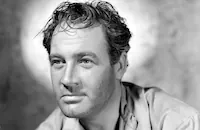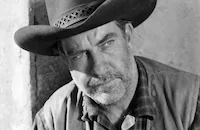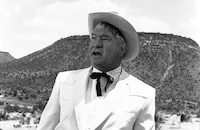Billy the Kid

Brief Synopsis
Cast & Crew
David Miller
Robert Taylor
Brian Donlevy
Ian Hunter
Mary Howard
Gene Lockhart
Film Details
Technical Specs

Synopsis
In 1880, in Lincoln, New Mexico, gunfighter William Bonney, known throughout the West as "Billy the Kid," forces crooked sheriff Cass McAndrews to free his friend, Pedro Gonzales, from jail. When Billy goes back to a saloon where Pedro was thrown out because he was a Mexican, local cattle baron Dan Hickey recognizes him by his left-handed draw and hires him to "persuade" some of the local ranchers to join their herds with his. Billy goes along when Hickey's gang stampedes a herd of cattle, and during the mêlée encounters Jim Sherwood, a friend from childhood. Jim tries to convince Billy to stop gunfighting, and the next day, goes to his boss, English rancher Eric Keating, to see if he will hire Billy. Keating goes to the saloon to warn Hickey to stop his violent tactics, then privately talks to Billy. Impressed that Keating uses words rather than a gun to make a point, Billy rides back to the ranch with him. On the way they find the body of Tom Patterson, a ranch hand who was killed in the stampede. Seeing Patterson's widow's grief, Billy feels ashamed, and when he meets Keating's pretty sister Edith, he decides to tell Hickey that he is quitting. Billy and Pedro then go to work for Keating, even though Keating warns Billy that he and Jim may some day turn into enemies. Billy is happy at the ranch until some time later, Pedro is shot in the back. Billy wants revenge against Hickey's men, who he is sure murdered Pedro, but Keating begs him to wait for a few days until he returns from talking with the governor about the lawlessness in Lincoln. On the night of Edith's birthday party, just after she and Jim have told Billy about their engagement, Keating's horse returns to the ranch without him. Billy then rides out and finds Keating dead, with a bullet in his back. Later, at the ranch, Patterson's widow incites the men to go after Hickey's gang, and Billy agrees to remain with them only as long as things go the way he wants. Hickey secretly gets word that Keating's men are riding into town and sends newspaper editor Tim Ward to tell them that Keating was killed while resisting arrest. The men do not believe the story, nor does Ward, who joins them as they ride into town. Pretending that he wants to talk, but secretly sending for reinforcements, Hickey meets with Jim and suggests that everyone give up their guns. When Billy and Ward refuse, Jim asks McAndrews to lock them in jail for their own protection. While in jail, Ward is able to grab a hammer and gives it to Billy. When Edith comes to ask Billy to listen to Jim, Billy sends her away, thinking that Jim has turned against him. Later McAndrews is ordered by Hickey to shoot Billy and say that he was attempting a jailbreak. Ward's hammer helps Billy get the sheriff's gun, and thinking that McAndrews is reaching for another, Billy kills him. He then goes after the men whom Ward has identified as Keating's killers and forces each to draw on him. Jim and Hickey find Billy after he has killed the last man. As Billy is about to shoot Hickey, Jim tries to dissuade him because he might be acquitted of killing the others, but Hickey runs and Billy shoots him in the back. Billy then tells Jim that he is coming by and reaches for his gun, but because he has shifted it to his right hand, Jim outdraws him. As Billy dies, Jim realizes that his friend deliberately let him win.

Cast

Robert Taylor

Brian Donlevy

Ian Hunter

Mary Howard

Gene Lockhart

Lon Chaney Jr.

Henry O'neill

Guinn Williams

Cy Kendall
Ted Adams
Frank Conlan

Frank Puglia
Mitchell Lewis
Dick Curtis

Grant Withers

Joe Yule
Earl Gunn
Eddie Dunn
Carl Pitti
Kermit Maynard
Ethel Griffies

Chill Wills

Olive Blakeney

Arthur Housman
Lew Harvey
Priscilla Lawson

Slim Whitaker

Ray Teal
Wesley White
Ben Pitti
George Chesebro
Jack L. King
Jules Cowles
Edwin J. Brady
Frank Hagney
Buck Mack
Tom London
Mario Costa
John Raitt
James Pickard
Obed Pickard Jr.
Ruth Pickard
Leila May Pickard
Ann Pickard
Crew
Daniele Amfitheatrof
Irving Asher
Lew Borzage
Jack Dawn
Bradbury Foote
Gene Fowler
Cedric Gibbons
Paul Groesse
Lennie Hayton
Henri Jaffa
Natalie Kalmus
Robert J. Kern
Albert Mannheimer
Warren Newcombe
Howard Emmett Rogers
Ormond B. Ruthven
Douglas Shearer
Al Shenberg
William V. Skall
Leonard Smith
David Snell
Gile Steele
Dolly Tree
Edwin B. Willis

Photo Collections
Videos
Movie Clip


Trailer
Film Details
Technical Specs

Award Nominations
Best Cinematography
Articles
Billy the Kid (1941)
The trouble really began when MGM publicist Howard Strickling set up a press conference for Taylor onboard the ship on which he was returning to America after shooting A Yank at Oxford (1938). Taylor tried to put to rest charges that he was only a pretty boy by declaring he "had hair on his chest." When the reporters insisted he bare his chest to prove it, Taylor refused the indignity which started the rumor mill churning. Those rumors did not die out after Taylor did bare his sufficiently hirsute chest in Three Comrades (1938) or when he married Barbara Stanwyck in 1939. The next logical step was to put him out west for some two-gun action.
There were other reasons for MGM to make a Billy the Kid picture at this time. For one, the Hollywood press was closely watching a new Howard Hughes production called The Outlaw (1943). Although Hughes was hampered by trouble with his director Howard Hawks, The Outlaw, which was also about Billy the Kid, was expected to complete shooting in early 1941. No one had any idea that it would take Hughes two more years to complete it. In addition, all the studios were turning to Westerns which played well in the American heartland now that World War II, then raging in Europe, had temporarily shut down the European market.
MGM owned the rights to the most popular book about the famous desperado, Walter Noble Burns' The Saga of Billy the Kid (1926), and had filmed it before in the early sound era with Johnny Mack Brown as the Kid and King Vidor behind the camera. The script was dusted off, revised, and the production announced in mid-December 1940 with Taylor in the lead, Maureen O'Sullivan as the love interest and two-time Academy Award winning director Frank Borzage in charge. Cast and crew set off for Flagstaff, Arizona for exteriors, returning before Christmas to shoot interiors on the lot.
With the New Year, Borzage and crew left for Tucson for more location shooting. Then on January 13, The Hollywood Reporter announced that Borzage had been taken off the production and David Miller sent to Tucson to complete the film. The official reason was that Borzage was required to shoot "Bombay Nights" with Joan Crawford, a picture that was either never made or released, and then to direct her in A Woman's Face (1941), a movie ultimately directed by George Cukor. Another odd thing about the switch is that David Miller, who had won awards for his Pete Smith Specialty shorts, had never directed a feature film and was now being handed on short notice an expensive A-list Technicolor Western.
Miller's contribution to the film was evidently substantial and may have been the result of a script re-write. O'Sullivan was now out, replaced by Mary Howard in a much-smaller role. Shooting went on until March with more location shooting in Monument Valley, Utah.
The final results were released at the end of May. Most of the reviewers of the time praised the scenery and color photography, which garnered an Academy Award nomination, but made backhanded comments about Taylor's masculinity. Bosley Crowther in The New York Times cattily remarked that, "The magnificence of Robert Taylor, which is always something special to behold, falls into pale inconsequence alongside the glories of the great outdoors in Metro's flashy technicolored Western." However, Taylor was to find vindication in the saddle. After the war, Taylor, looking tougher and more mature, would play convincing Western heroes in such movies as Westward the Women (1951) and The Law and Jake Wade (1958). By then, no one doubted that the actor had hair on his chest.
Director: David Miller, Frank Borzage
Producer: Irving Asher
Screenplay: Gene Fowler, based on the novel The Saga of Billy the Kid by Walter Noble Burns and the story by Howard Emmett Rogers and Bradbury Foote
Cinematography: William V. Skall, Leonard Smith
Set Decoration: Edwin B. Willis
Music: David Snell
Editing: Robert J. Kern
Cast: Robert Taylor (Billy the Kid), Brian Donlevy (Jim Sherwood), Ian Hunter (Eric Keating), Mary Howard (Edith Keating), Gene Lockhart (Dan Hickey), Lon Chaney, Jr. (Spike Hudson), Henry O'Neill (Tim Ward), Frank Puglia (Pedro Gonzales).
C-94 min. Closed captioning.
by Brian Cady

Billy the Kid (1941)
Quotes
Jim's got roots here.- Edith
I got a horse and the west is wide.- Billy
Trivia
Maureen O'Sullivan was initially cast in the role of "Edith Keating" but left to be with her husband, director John Farrow, who was with the RCAF in Canada.
Right-handed Robert Taylor spent weeks perfecting his ability to draw a gun with his left hand in preparation for this film.
Notes
The opening title card reads, "Metro-Goldwyn-Mayer presents Robert Taylor as Billy the Kid," but the end credits list Taylor's role as "William Bonney." A written opening prologue introduces "...a young outlaw who lived his violent hour in defiance of an advancing civilization. His name has gone down in legend as 'Billy the Kid.'" A written epilogue reads: "Thus the ways of law came to the last frontier, the last of the men of violence found his peace."
When Billy the Kid began filming in mid-December 1940, Frank Borzage was the director and his brother Lew was the assistant director. According to Hollywood Reporter production charts and news items, Borzage directed portions of the film that were shot on location in Tucson and Flagstaff, AZ. A Hollywood Reporter news item on January 13, 1941 reported that Borzage was being taken off the production and reassigned to a Joan Crawford project entitled Bombay Nights. [That project was never made]. At that time, David Miller was assigned to direct Billy the Kid. The news item also notes that all of the remaining scenes were to be shot on M-G-M's Culver City lot.
Later news items, feature articles and production charts confirm that additional location shooting took place in Monument Valley, AZ, in late January and early February 1941, that the production concluded in late Mar, but that some additional scenes and retakes were needed in mid-Apr, all directed by Miller with Al Shenberg acting as assistant director. A New York Times article about the production noted that veteran M-G-M director Norman Taurog acted as a "supervisor" for Miller during some of the production because it was Miller's first feature. New York Times also noted that the town of Lincoln, NM, was reproduced on M-G-M's backlot. According to a March 11, 1941 Hollywood Reporter news item, the production was the longest on M-G-M's lot since Gone With the Wind [which was only partially shot at M-G-M] following Miller's replacement of Borzage.
Another news item noted that Maureen O'Sullivan, who had previously co-starred with Taylor in two 1938 films, The Crowd Roars and A Yank at Oxford (see AFI Catalog of Feature Films, 1931-40; F3.0893 and F3.5522) was initially cast in the role of "Edith Keating," but left the production to go to Canada to join her husband, director John Farrow, who was in the RCAF. Although Sullivan's name appears in the first Hollywood Reporter production chart for the film, on December 13, 1940, it is probable that she left the production prior to the start of shooting. Actress Connie Gilchrist is credited in early M-G-M press releases and the CBCS in the role of "Mildred," but neither she nor the character were in the viewed print or mentioned in reviews, and it is likely that the role was cut from the final film. Lon Chaney, Jr., who had recently been put under contract to Universal, was borrowed by M-G-M for the picture. Cinematographers William V. Skall and Leonard Smith earned an Academy Award nomination for their work on the film.
The real "Billy the Kid," who was born Henry McCarty in New York City on November 28, 1859, changed his name to William Antrim when his widowed mother remarried. Traveling West at an early age, he assumed the name William H. Bonney and soon earned a reputation as a "fast gun" and killer, known as "Billy the Kid." He was killed on July 14, 1881 in Lincoln County, NM by Sheriff Pat Garrett. Although modern historical sources, including a March 30, 1941 New York Times acticle, indicates that the real outlaw did work for an English-born rancher, named Tunstall, who was killed by a rival, historical documentation on the gunfighter indicates that the film was inspired by legend rather than reality, as all of the characters in the film are fictional except Billy, and few documented facts are included.
One aspect of the real Billy that has been disputed among historians is whether or not he was right or left-handed. In the film, Taylor, who was himself right-handed, portrays the character as a left-handed gunman. The fact that Billy May have been left-handed is supported by a well-known tintype photograph that shows him holding a gun in his left hand. According to Western historians, among them noted silent-film star William S. Hart, who are quoted in a August 4, 1941 Life magazine article on the film, the "left-handed" Billy photograph was made from a reversed negative. This fact is supported by physical evidence on the gun itself, which is in the collection of the Gene Autry Western Heritage Museum in Los Angeles, CA. The issue of whether Billy was left-or right-handed is important to the M-G-M film because during the climactic shootout between Billy and his friend, "Jim Sherwood," Sherwood (portrayed by Brian Donlevy) outdraws the faster Billy because Billy deliberately switches the gun to his slower right hand, indicating that he chose his own death rather than kill his friend. Billy the Kid has been portrayed as both left-and right-handed in the numerous films in which he has been a featured character. The Howard Hughes production of The Outlaw, that was shot almost simultaneous to the M-G-M, but not distributed nationally until 1946, featured a right-handed Billy (see below).
Among the many other films that featured Billy the Kid were, the 1930 M-G-M feature Billy the Kid, directed by King Vidor and starring Johnny Mack Brown and Wallace Beery (see AFI Catalog of Feature Films, 1921-30; F2.0419), the 1958 Warner Bros. film The Left-Handed Gun, directed by Arthur Penn and starring Paul Newman, M-G-M's 1973 film Pat Garrett and Billy the Kid, directed by Sam Peckinpah, and starring James Coburn and Kris Kristofferson, and a series of eighteen PRC released features that begin with Billy the Kid Outlawed in 1940 (see AFI Catalog of Feature Films, 1931-40; F3.0341) directed by Peter Stewart and starring Bob Steele, who relinquished the title role to Buster Crabbe in 1941. The Aaron Copeland ballet Billy the Kid, first performed in 1939, was also inspired by the life of the outlaw, as have been countless television programs.

















